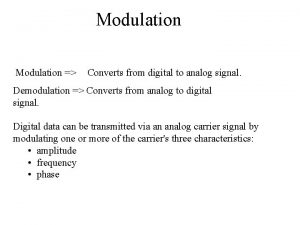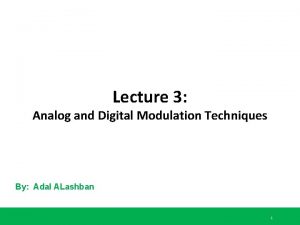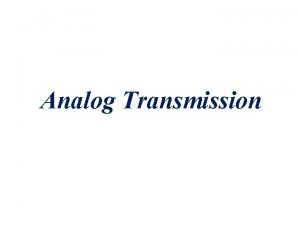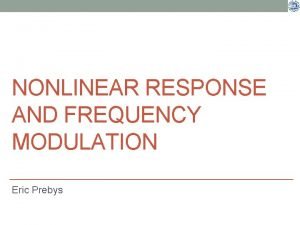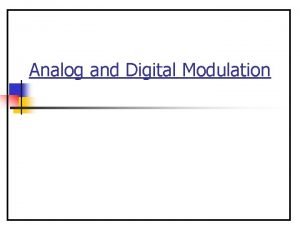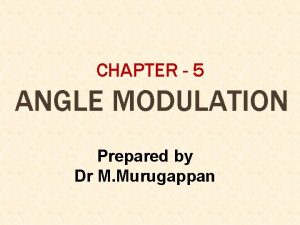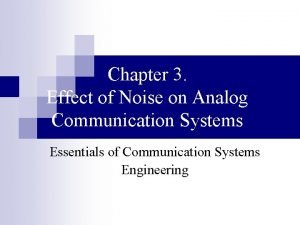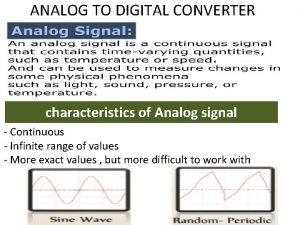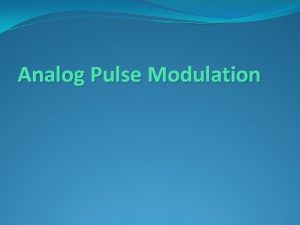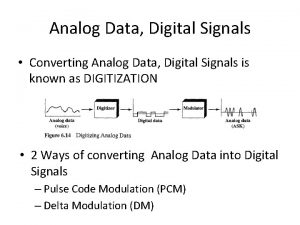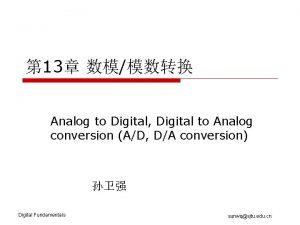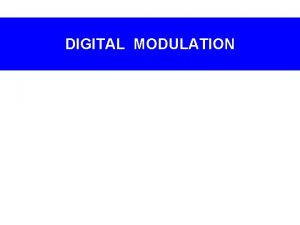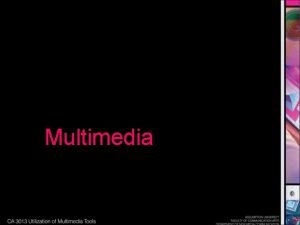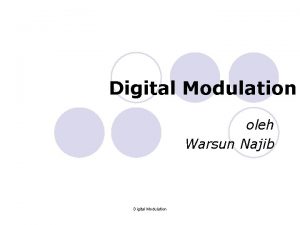Modulation Conversion of digital information to analog signals










- Slides: 10

Modulation • Conversion of digital information to analog signals – Example: Telephone lines are band-limited (300 -3300 Hz) • Modem = modulator/demodulator • Characteristics of defining sine waves: – Amplitude – Frequency – Phase Winter 2005 ECE Change one or more of them to send information ECE 766 Computer Interfacing and Protocols 05 - 1

Modulation • Modulation Techniques – Amplitude Shift Keying (ASK) – Frequency Shift Keying (FSK) – Phase Shift Keying (PSK) Quadrature Amplitude Modulation (QAM) • Aspects of Modulation – Bit rate vs. Baud rate Bit rate ≥ Baud rate – Carrier Signal Winter 2005 ECE 766 Computer Interfacing and Protocols 05 - 2

Amplitude Shift Keying (ASK) • Basic technique (like AM) change the amplitude of the signal to transfer logical values Amplitude 0 1 Time 1 baud 1 second • On-Off Keying (OOK) • Highly susceptible to noise • Inefficient Winter 2005 ECE 766 Computer Interfacing and Protocols 05 - 3

Amplitude Shift Keying (ASK) • Bandwidth requirement Amplitude Minimum Bandwidth = Nbaud Frequency fc-(Nbaud/2) fc fc+(Nbaud/2) • BW = (1+d) x Nbaud • d ≥ 0 related to the condition of the line Winter 2005 ECE 766 Computer Interfacing and Protocols 05 - 4

Frequency Shift Keying (FSK) • Represent each logical value with another frequency (like FM) Amplitude 0 1 Time 1 baud 1 second • Not susceptible to noise as much as ASK • Limiting factor: Physical capabilities of the carrier Winter 2005 ECE 766 Computer Interfacing and Protocols 05 - 5

Frequency Shift Keying (FSK) • Bandwidth requirement Amplitude BW=fc 1 --fc 0+Nbaud fc 1 --fc 0 Nbaud/2 Frequency fc 0 fc 1 • How about duplex communication? Winter 2005 ECE 766 Computer Interfacing and Protocols 05 - 6

Phase Shift Keying (PSK) • Use different phased signals to represent binary values Reference – 0 = in phase with reference – 1 = out of phase with reference Amplitude 0 1 Time 1 baud • Not practical Winter 2005 ECE 1 baud 1 second ECE 766 Computer Interfacing and Protocols 05 - 7

Phase Shift Keying (PSK) • Differential PSK – 0 = same phase as last signal element – 1 = 180º shift from last signal element Amplitude 0 1 1 0 Time 1 baud 1 second • Constellation Diagram: Winter 2005 ECE 1 ECE 766 Computer Interfacing and Protocols 0 05 - 8

Phase Shift Keying (PSK) • Quadrature Phase Shift Keying (Q-PSK): Do not only use 180º shift 010 01 011 10 001 00 11 4 -PSK (Q-PSK) 000 111 101 110 8 -PSK • Min. BW requirement: same as ASK! • Self clocking (most cases) Winter 2005 ECE 766 Computer Interfacing and Protocols 05 - 9

Quadrature Amplitude Modulation (QAM) • Combine ASK and PSK such that each signal corresponds to multiple bits 3 amplitudes 12 phases • More phases than amplitudes • Minimum bandwidth requirement same as ASK or PSK Winter 2005 ECE 766 Computer Interfacing and Protocols 05 - 10
 Modulation digital to analog
Modulation digital to analog Analog and digital modulation techniques
Analog and digital modulation techniques Analogue and digital transmission in computer networks
Analogue and digital transmission in computer networks Digital to analog conversion in data communication
Digital to analog conversion in data communication Amplitude modulation vs frequency modulation
Amplitude modulation vs frequency modulation Wave modulation
Wave modulation Advantages of angle modulation
Advantages of angle modulation White noise in analog communication
White noise in analog communication Digital data digital signals
Digital data digital signals Data encoding and transmission
Data encoding and transmission Characteristics of analog signals
Characteristics of analog signals
